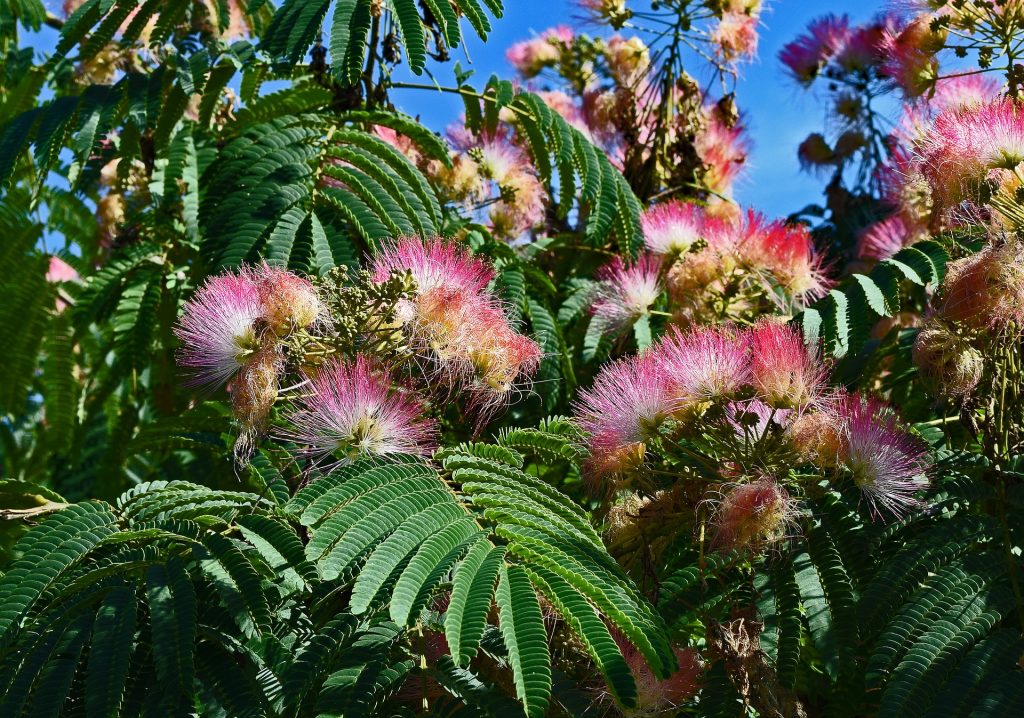 Mimosa (Albizia julibrissin) is commonly known as the Persian silk tree, pink siris or pink silk tree. Mimosa is a species of tree that belongs to the Fabaceae (legume) family of plants, and it grows natively in southwest and eastern Asia. The leaves of the tree are interesting in that they slowly close at night, with is why it is sometimes also called night sleeper or sleeping tree. The tree can grow to about 15 meters in height, and during the summer it produces flowers with pink silky threads, from which it derives its common names. Traditionally mimosa barks extracts have been used to treat insomnia, mental trauma and as a calmative, and science is now corroborating these effects. Human studies utilising mimosa are limited, but extracts of the tree, both flower and bark, have a long history of use in traditional medicine. Mimosa may not be available as widely as many other herbs presented in this book, but it is an integral part of Traditional Chinese Medicine, and as such is commercially available.
Mimosa (Albizia julibrissin) is commonly known as the Persian silk tree, pink siris or pink silk tree. Mimosa is a species of tree that belongs to the Fabaceae (legume) family of plants, and it grows natively in southwest and eastern Asia. The leaves of the tree are interesting in that they slowly close at night, with is why it is sometimes also called night sleeper or sleeping tree. The tree can grow to about 15 meters in height, and during the summer it produces flowers with pink silky threads, from which it derives its common names. Traditionally mimosa barks extracts have been used to treat insomnia, mental trauma and as a calmative, and science is now corroborating these effects. Human studies utilising mimosa are limited, but extracts of the tree, both flower and bark, have a long history of use in traditional medicine. Mimosa may not be available as widely as many other herbs presented in this book, but it is an integral part of Traditional Chinese Medicine, and as such is commercially available.

It is not clear which phytochemical is the main active ingredient responsible for the antidepressant, anxiolytic and sedative effects of mimosa. However phenolic glycosides, triterpenes and flavonoids have all been isolated from the plant and may contribute to its medicinal effects. Mimosa contains a group of phytochemicals called julibrosides. Julibrosides are triterpenoid saponins and are similar in structure to the ginsenosides found in the ginseng plant. Structurally they have a central steroid ring structure with various sugars attached in differing configurations, producing a wide range of similar compounds. This may suggest that some of the antidepressant and anxiolytic effects of mimosa are elicited through mechanisms similar to that seen in ginseng. However, two flavonol glycosides, quercitrin and isoquercitrin isolated from the flowers of the mimosa tree has been shown to induce sleep in mice. Of these compounds quercitrin appears to have the strongest activity in mice. This suggests that that the flavonoids present in the mimosa tree may be responsible for some of its medicinal effects.
Extracts of mimosa have been investigated for their antidepressant effects in animals. For example, acute treatment of mice with mimosa extract produced significant antidepressant effects in the animals, compared to the control. In this study, the antidepressant effects of the mimosa was comparable to the antidepressant drug imipramine. Extracts of mimosa have also been investigated for their anxiolytic effects in animals. For example, administration of mimosa extract caused a significant reduction in the anxiety experienced by rats exposed to stressful conditions. In another study, mimosa extracts caused a significant hypnotic and sedative effect in mice, suggesting it could be useful agents to treat insomnia. Analysis of animal models to determine a mechanisms of action reveals that extracts of mimosa can bind to both the benzodiazepine and serotonin receptor. The effects of this receptor binding would be to cause a decrease in excitatory pathways in the brain, inducing anxiolytic and sedative effects.
Eat Well, Stay Healthy, Protect Yourself
RdB
